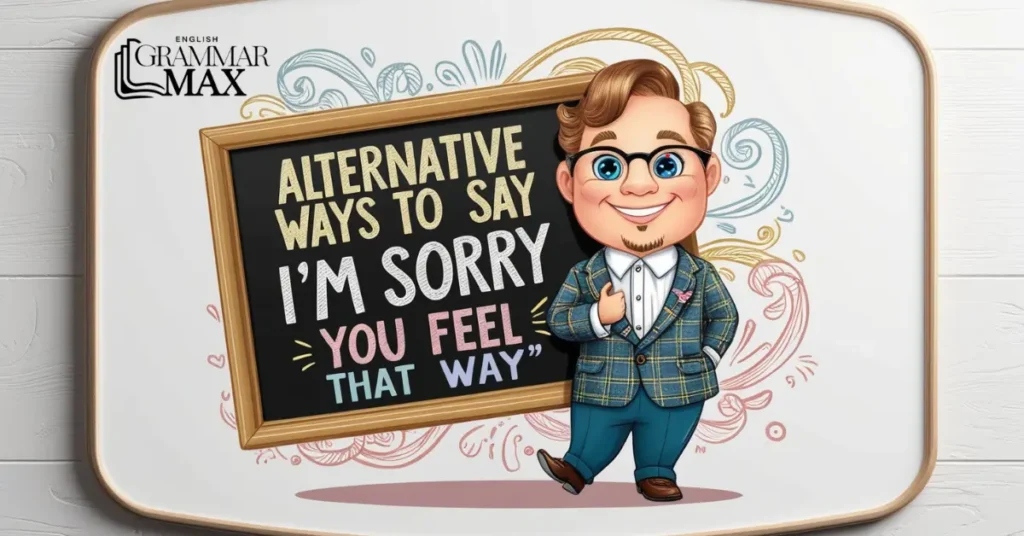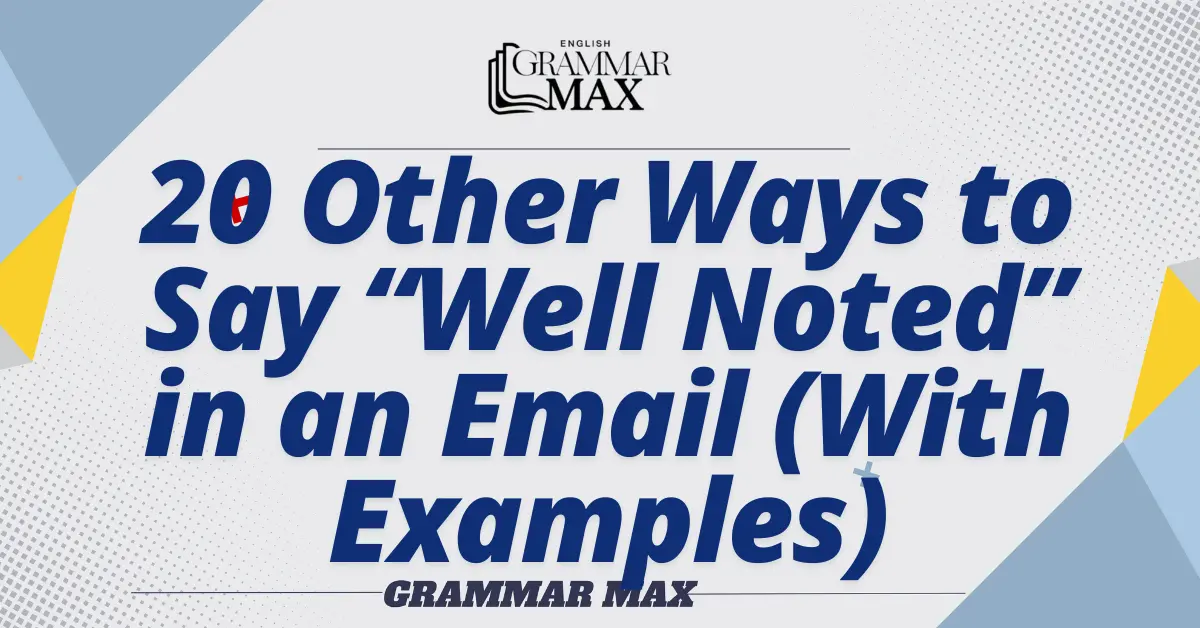In professional settings, handling complaints and resolving issues with empathy is crucial for maintaining positive relationships. The phrase “I’m sorry you feel that way” is often used to acknowledge a concern, but it may come across as dismissive or lacking in empathy. Knowing what to say instead of “I’m sorry you feel that way” can help you express understanding, offer solutions, and strengthen rapport with clients or colleagues.
This article presents 23 alternatives, complete with usage examples, to help you express empathy and address concerns professionally.
Alternative ways to say “I’m Sorry You Feel That Way”

Here’s 23 alternative ways to say “I’m sorry you feel that way”:
- I’m sorry I made you feel that way
- I understand how frustrating this must be for you
- I truly regret the inconvenience this has caused
- Thank you for bringing this to my attention
- I appreciate your feedback, and I’m working on improving
- I’m sorry we didn’t meet your expectations
- We are committed to resolving this issue for you
- I’m sorry for any misunderstanding
- I can see how this would be upsetting
- Your experience is important to us, and we’re here to help
- I apologize for any confusion this may have caused
- Let’s explore a solution together
- I’m sorry for the inconvenience. How can we make this right?
- I’m sorry you felt that way, but I’d like to clarify
- I understand your concerns, and we’re taking steps to improve
- I understand that this situation is challenging
- I regret any disappointment this may have caused you
- I value your perspective and would like to address it
- I appreciate your patience as we work through this
- I’m committed to learning from this experience
- I’m here to support you in resolving this issue
- I want to ensure that your concerns are addressed
- I’m here to listen to your concerns
1. “I’m sorry I made you feel that way.”
When to use: This phrase acknowledges that your actions may have contributed to the person’s feelings, showing accountability. It is a compassionate response that can diffuse tension in a conversation, making it clear that you are taking responsibility.
Example:
“Hi Sarah, I’m sorry I made you feel that way during our meeting. That wasn’t my intention, and I’d like to understand more about what caused your discomfort so we can work on improving our communication.”
2. “I understand how frustrating this must be for you.”
When to use: Expressing understanding of someone’s emotions is a great way to connect with clients or coworkers without sounding dismissive. This phrase helps convey that you empathize with their situation and are willing to help.
Example:
“Dear Mr. Jones, I understand how frustrating this must be for you. Let’s work together to find a solution that meets your needs.”
3. “I truly regret the inconvenience this has caused.”
When to use: Use this phrase when you want to emphasize your empathy for the trouble someone has gone through, particularly in customer service scenarios. It sounds more sincere than a generic apology and shows that you genuinely care.
Example:
“Dear Emily, I truly regret the inconvenience this has caused. We’re doing everything we can to resolve the issue as quickly as possible.”
4. “Thank you for bringing this to my attention.”
When to use: This is a great way to acknowledge concerns while maintaining a professional tone. It emphasizes that you value feedback and are open to addressing issues.
Example:
“Hi John, thank you for bringing this to my attention. I’ll make sure to look into it immediately and get back to you with an update.”
5. “I appreciate your feedback, and I’m working on improving.”
When to use: This phrase is useful when dealing with constructive feedback. It shows you are aiming to learn and improve based on their input, which is important for continuous professional development.
Example:
“Hi Rachel, I appreciate your feedback, and I’m working on improving the way I handle these situations in the future.”
6. “I’m sorry we didn’t meet your expectations.”
When to use: When addressing customer dissatisfaction, it’s essential to acknowledge the issue without sounding defensive. This phrase helps to show that you recognize the gap between their expectations and what was delivered.
Example:
“Dear Mr. Thompson, I’m sorry we didn’t meet your expectations with our service. I’d like to explore how we can make things right moving forward.”
7. “We are committed to resolving this issue for you.”
When to use: Expressing a commitment to resolve issues reassures the person that you are actively working to find a solution. This helps rebuild trust after a negative experience.
Example:
“Dear Susan, we are committed to resolving this issue for you as quickly as possible. I’ll personally oversee the matter to ensure it’s handled promptly.”
8. “I’m sorry for any misunderstanding.”
When to use: Sometimes, miscommunication can lead to disagreements or disappointments. This phrase acknowledges that there may have been a breakdown in communication without placing blame.
Example:
“Hi Mike, I’m sorry for any misunderstanding. Let’s clarify the details and make sure we’re on the same page moving forward.”
9. “I can see how this would be upsetting.”
When to use: Expressing empathy for someone’s feelings helps you connect with them emotionally. This phrase shows that you recognize the emotional impact of the situation and are compassionate.
Example:
“Dear Mrs. Stevens, I can see how this would be upsetting given the circumstances. Let’s work together to explore a solution that works for you.”
10. “Your experience is important to us, and we’re here to help.”
When to use: This is ideal for situations involving customer complaints or negative feedback. It shifts the focus from the problem to a solution, offering assistance and support.
Example:
“Hi David, your experience is important to us, and we’re here to help. Let me know how we can best assist you in resolving this issue.”
11. “I apologize for any confusion this may have caused.”
When to use: This phrase is suitable when there may have been confusion or misinterpretation involved. It shows that you are aware of the misunderstanding and are willing to clear things up.
Example:
“Dear Samantha, I apologize for any confusion this may have caused. Please allow me to clarify the details and ensure everything is in order.”
12. “Let’s explore a solution together.”
When to use: This collaborative phrase invites the other party to participate in problem-solving, which can help to resolve issues in a way that satisfies both sides. It encourages teamwork and shows that you are invested in finding a solution.
Example:
“Hi Alex, let’s explore a solution together that addresses your concerns and ensures a positive outcome for both of us.”
13. “I’m sorry for the inconvenience. How can we make this right?”
When to use: Offering to make things right is a proactive approach that shows you are willing to go the extra mile to resolve issues. It also gives the other person the chance to express what they need to feel satisfied.
Example:
“Hi Chris, I’m sorry for the inconvenience. How can we make this right for you? I want to ensure you’re happy with the outcome.”
14. “I’m sorry you felt that way, but I’d like to clarify.”
When to use: This phrase allows you to acknowledge the person’s feelings while offering clarification. It can be used when you feel the need to correct any misconceptions or provide further explanation.
Example:
“Dear Mr. Anderson, I’m sorry you felt that way, but I’d like to clarify what happened from our side. I hope this helps clear up any misunderstandings.”
15. “I understand your concerns, and we’re taking steps to improve.”
When to use: This phrase is perfect for addressing concerns while showing that you are aiming to learn and improve. It’s especially useful in a workplace setting where continuous improvement is valued.
Example:
“Dear Ms. Lewis, I understand your concerns, and we’re taking steps to improve based on your feedback. We appreciate you sharing your experience with us.”
16. “I understand that this situation is challenging.”
When to use: This phrase acknowledges the difficulty of the situation for the other person, demonstrating empathy. It shows that you recognize their struggle and are willing to support them.
Example:
“Hi Lisa, I understand that this situation is challenging for you. I want to work with you to find a resolution that alleviates your concerns.”
17. “I regret any disappointment this may have caused you.”
When to use: Use this phrase when a situation has not met expectations, particularly in customer service. It reflects awareness of the impact your actions may have had and conveys genuine concern.
Example:
“Dear Mr. Clark, I regret any disappointment this may have caused you. Your satisfaction is important to us, and I’m here to assist in resolving the matter.”
18. “I value your perspective and would like to address it.”
When to use: This phrase highlights the importance of the other person’s feelings and opinions, fostering a sense of connection. It shows that you are willing to engage in dialogue and address concerns directly.
Example:
“Hi Nancy, I value your perspective and would like to address it. Let’s discuss what we can do to improve the situation.”
19. “I appreciate your patience as we work through this.”
When to use: Expressing gratitude for someone’s patience reinforces a positive interaction. This phrase acknowledges that the process may take time while also showing respect for the individual’s feelings.
Example:
“Dear Mr. Davis, I appreciate your patience as we work through this. I’m committed to ensuring a satisfactory resolution for you.”
20. “I’m committed to learning from this experience.”
When to use: This phrase indicates that you view feedback as an opportunity for growth and improvement. It demonstrates a willingness to reflect on the situation and adapt moving forward.
Example:
“Hi Karen, I’m committed to learning from this experience to improve our service. Thank you for sharing your thoughts with me.”
21. “I’m here to support you in resolving this issue.”
When to use: This phrase emphasizes your role as a supportive partner in the resolution process. It shows that you are actively involved and available to assist the other person.
Example:
“Dear Tom, I’m here to support you in resolving this issue. Please let me know how I can assist you further.”
22. “I want to ensure that your concerns are addressed.”
When to use: This phrase underscores your commitment to taking the other person’s concerns seriously. It assures them that their feelings are valid and that you are dedicated to finding a solution.
Example:
“Hi Ella, I want to ensure that your concerns are addressed. Let’s talk about how we can rectify the situation to your satisfaction.”
23. “I’m here to listen to your concerns.”
When to use: This phrase invites open communication and shows that you are ready to engage with the other person’s feelings. It is particularly effective when the other party needs to vent or express their frustration.
Example:
“Dear Mr. Wilson, I’m here to listen to your concerns and understand how we can improve. Your input is invaluable to us.”
When to Use These Phrases?
Use these phrases when addressing concerns, managing customer dissatisfaction, or responding to feedback. They are ideal for situations requiring empathy and understanding, such as handling complaints, navigating conflict resolution, or facilitating effective communication. By selecting the right phrase, you can enhance relationships, foster trust, and promote a culture of collaboration in professional settings.
Is it Professional to Say “I’m Sorry You Feel That Way”

Saying “I’m sorry you feel that way” can often come across as dismissive and may lack genuine empathy, making it less professional in sensitive situations. While it acknowledges the other person’s feelings, it does not take responsibility for the situation or offer a constructive path forward. In a professional context, it’s more effective to express understanding and propose solutions. Opting for more empathetic phrases can enhance communication, demonstrate compassion, and ultimately lead to better conflict resolution, fostering stronger relationships and improving customer satisfaction.
Frequently Asked Question
Is “sorry you feel that way” gaslighting?
It’s not outright gaslighting, but it can feel invalidating if used to shut down someone’s emotions. 🤷♀️
How do you interpret “I’m sorry you feel that way”?
It often feels like the person isn’t really owning up to their actions, just pushing the feelings back on you.
Is it passive-aggressive to say “I’m sorry you feel that way”?
Yep, it can totally come off as passive-aggressive, especially if there’s no effort to fix things. 😬
How do you apologize for making someone feel a certain way?
Say, “I’m sorry I made you feel that way” and actually mean it! Plus, offer to make things better.
Conclusion
The way you apologize or acknowledge someone’s feelings can significantly impact the outcome of a situation. By choosing alternatives to “I’m sorry you feel that way”, you can express empathy while maintaining professionalism, helping to resolve issues and strengthen your relationships. Remember to address concerns with understanding and offer to explore solutions together, ensuring that both parties feel heard and valued.
Using these 23 professional alternatives, you can effectively handle complaints, manage customer dissatisfaction, and ensure positive, constructive communication in your workplace.

William Henry is a writer for Grammar Max, a blog that focuses on synonyms and phrases. He loves exploring the quirks of the English language and enjoys helping readers improve their vocabulary. William’s articles are easy to read, fun, and full of useful tips for anyone looking to better understand and use English. Whether you’re a student, a professional, or just someone interested in language, William’s writing on Grammar Max makes learning about words and their meanings simple and enjoyable.





